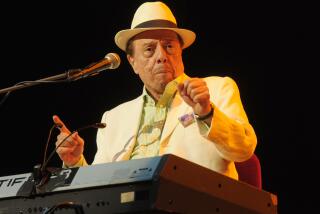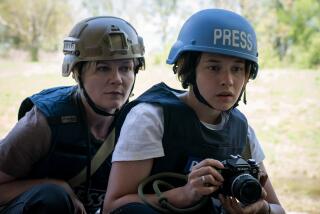Review: Sam Mendes’ World War I drama ‘1917’ is a technical triumph — and a half-successful experiment
Sometime after nightfall in “1917,” a gravely virtuosic dispatch from the front lines of World War I, a British soldier, Lance Cpl. Schofield (George MacKay), makes his way through a darkened building amid the ruins of a bombed-out French village. There, in a shadowy room illuminated by overhead flares and rattled by distant explosions, he stumbles on a frightened young woman (Claire Duburcq) in hiding.
They communicate in gestures and whispers. She sees that he’s wounded and tenderly touches his bloodied head; he winces in pain but gratefully accepts. There’s a surreal, even ghostly feel to this encounter, a fleeting moment of consolation in a place suffused with death. For the audience, it’s a delicate interlude in a dark, violent story; for Schofield, it offers respite but no escape from a hell on earth that has raged for three years and shows little sign of abating.
The movie’s simple title and taut time frame — it unfolds over two consecutive days in April 1917 — serve as a grim reminder to the audience that the war will rage on for more than a year. But for the most part, English director Sam Mendes (who wrote the script with Krysty Wilson-Cairns) avoids granting us any knowledge not already possessed by his characters. His aim is to convey, with immersive realism and real-time immediacy, the experience of two men on an overnight mission — one that may look small in the war’s grander context but, like many such missions, serves a crucial purpose.
Inspired by stories that Mendes heard from his grandfather, Alfred Mendes, a veteran of the war’s Belgian front, “1917” follows Schofield and Lance Cpl. Blake (Dean-Charles Chapman), young men stationed in northern France. Blake is the louder and livelier of the two, a raconteur with a poetic streak who rhapsodizes longingly about his family’s cherry orchard. Schofield is quieter, more withdrawn and disillusioned. The traumas of the Battle of the Somme are still fresh, leaving him with awful memories and a medal he neither wears nor talks about.
Further horrors and tests of bravery await. The ticktock-thriller plot is set in motion by a general (Colin Firth) who instructs Schofield and Blake to travel on foot over miles of bloodied, bombed-out terrain to deliver a warning to the Second Battalion of the Devonshire Regiment, which is planning an imminent attack on fleeing German forces. But what appears to be an enemy retreat is actually a brilliant tactical calculation; the battalion’s 1,600 troops, who include Blake’s brother, are walking into a skillfully orchestrated trap.
And a skillfully orchestrated trap seems as fitting a way as any to think of “1917,” in which the rawness and brutality of the Great War have been largely tamed into aesthetic submission. The movie is a powerfully incongruous hybrid: a soldier’s lament and a formalist’s delight. Reuniting with the great cinematographer Roger Deakins, his collaborator on “Skyfall,” “Revolutionary Road” and “Jarhead,” Mendes has constructed “1917” so as to simulate the appearance of one unbroken take — a long, sinuous tracking shot sustained without any visible cuts. (The clever peekaboo editing is by Lee Smith, who also cut Christopher Nolan’s “Dunkirk,” a war epic as fragmented as this one is seamless.)
The result is a two-hour tightrope walk that keeps us intently focused on these men and their mission, never allowing us to look away even when we’d like to. By the time Blake and Schofield receive their marching orders, the camera has already followed them through several hundred yards’ worth of trenches. Mendes fills the widescreen frame with deft pointillist flourishes; he’s fond of pulling back and letting the background come into focus, giving us just enough time to register the sight of other soldiers — working, playing and bickering in their filthy uniforms and steel helmets — before whisking us on to the next episode.
The camera will remain alongside Blake and Schofield as they venture out of the ditches and across a no man’s land etched with craters and barbed wire. (The scorched-earth production design is by Dennis Gassner.) Inch by grisly inch, they make their way through a gnarled labyrinth of deserted fortifications and sun-bleached human skeletons lying embedded and forgotten in the craggy terrain, all bearing silent witness to a war seemingly without end.
In these moments, “1917” casts aside the chaotic grammar of the combat picture and takes on the hushed eloquence of a post-apocalyptic horror movie. Rarely have two men seemed so utterly alone: Here there are only the remnants of battle, a few skittering rats and the stench of mass death. The overall effect of Mendes’ blocking and camerawork, staggeringly complicated though it must have been to pull off, is disarmingly spare and simple. His technique weaves an undeniable spell, sometimes deepened and sometimes broken by a Thomas Newman score that veers from low, ominous drones to majestic orchestral surges.
Mendes is good at building tension within the frame, even as his gently drifting, weightless camera conveys the oddly pleasurable feeling of a guided tour. He has a talent for luring his protagonists, and the audience, into an eerie calm, only to jolt us with a showman’s sense of cunning. There are at least two moments when the movie brutally ambushes its characters — once with a circling fighter plane that winks at “North by Northwest,” and later with a devastatingly swift attack that takes place, perversely, when the camera isn’t looking.
I realize that nearly everything I have written has characterized “1917” in terms of its visual choreography, which undersells the actors — MacKay and Chapman are both heartrendingly good — but also speaks to the limitations of Mendes’ formal conceit. He is one of many filmmakers, from Max Ophüls and Andrei Tarkovsky to Alfonso Cuarón, who have embraced the tracking shot, in which time itself is given weight and physicality by the unified movement of the camera. A few movies have stretched the technique to feature-length, like Alexander Sokurov’s “Russian Ark” (2002) and Sebastian Schipper’s “Victoria” (2015), both notably executed the hard way, with no postproduction trickery.
By contrast, movies like Alejandro G. Iñárritu’s “Birdman” and now “1917” create their visual continuity using techniques that would have been unimaginable in the predigital era. One of the distractions of Mendes’ movie is that you may spend a lot of time looking for those hidden edits, those moments when the camera effectively “blinks.” (It’s like a higher-tech version of Alfred Hitchcock’s 1948 one-take wonder, “Rope.”) It’s a fun game, but it also gets at the paradox of so much extended long-take cinema: A device meant to be seamless and immersive can’t help but keep drawing your attention to its own impeccable craftsmanship.
Perhaps it’s because Schofield and Blake are making their way through Gallic terrain, but “1917” at times brought to mind the words of two French-born filmmakers who were themselves once fellow travelers. “There’s no such thing as an antiwar film” is a quote often attributed to François Truffaut, and it was Jean-Luc Godard who said, “Film is truth 24 times per second, and every cut is a lie.”
Intentionally or not, “1917” feels like an attempted rejoinder to both those famous declarations. Genuinely uninterested in glorifying the spectacle of war, Mendes deploys technological trickery in pursuit of a new kind of cinematic truth.
I think he half succeeds. There are times when the nonstop visual momentum lends “1917” the feel of a virtual-reality installation, and others when the simulation of raw immediacy slips to reveal the calculated construct underneath. Mendes’ films have had a weakness for overly pristine surfaces — in evidence since his Oscar-winning debut feature, “American Beauty” — and his coolly detached, slightly bloodless aestheticism makes for an odd but fascinating fit with the war movie, a genre that often encourages filmmakers to unleash a full-blown sensory assault.
“1917,” by contrast, keeps its composure, giving you the distance to process its assiduously doled-out horrors; it only occasionally achieves gut-level impact, but it also doesn’t try to bludgeon you in submission. If Mendes has not made an antiwar movie in the unattainable Truffautian sense, he has nonetheless rendered a thoughtful, clear-eyed argument for the futility and endlessness of armed conflict, a message that reverberates well beyond these particular front lines into the present.
At one point, a wise captain (Mark Strong) tells Schofield that even if he makes it to his destination, his attempt to call off the attack may be in vain: “Some men just want the fight.” He is one of several peripheral characters — played by actors including Firth, Andrew Scott, Benedict Cumberbatch and an especially good Richard Madden — who show up to offer a few often-cynical words of counsel before sending them on their way.
Their famous faces may pull you briefly out of the movie, but seeing each one is pleasurable all the same — and instructive. Taken together, they suggest that “1917” might be best approached not as a work of strict realism but as a knowing hybrid of authenticity and artifice. It’s worth recalling that Mendes is a longtime theater director, which may explain some of the movie’s more brazenly operatic gestures: In one stunning nighttime scene, Deakins’ camera rises over those fire-lit ruins, transforming a disaster zone into a stage as Newman’s score rises in a mighty crescendo. It may be a grandiose flourish, but you can’t deny it makes for a startlingly literal theater of war.
‘1917’
Rating: R, for violence, some disturbing images and language
Running time: 2 hours
Playing: Opens Dec. 25 in general release
More to Read
Only good movies
Get the Indie Focus newsletter, Mark Olsen's weekly guide to the world of cinema.
You may occasionally receive promotional content from the Los Angeles Times.











